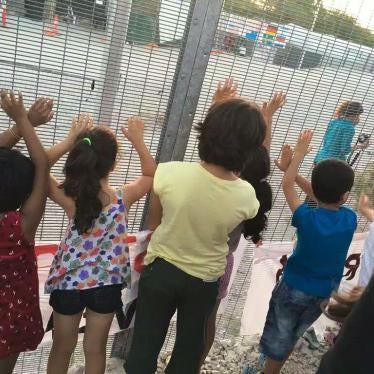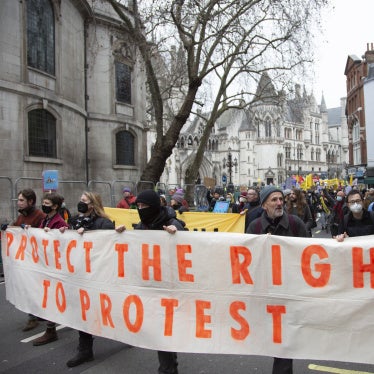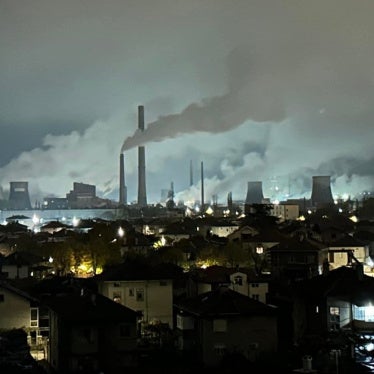This submission relates to the review of Aotearoa New Zealand under the Convention on the Rights of the Child. This submission focuses on the right to education.
Access to Education (article 28)
Removal of Secondary School Qualification Fees
From August to November 2017, Human Rights Watch researched students’ access to quality, inclusive, free education in 33 New Zealand secondary schools, particularly schools with students from low socio-economic communities. This research focused on the impact of fees charged for the National Certificate in Educational Achievement (NCEA) qualification.[1] Human Rights Watch found that the fee charged to students for the NCEA affected some students’ ability to obtain their NCEA qualification. Students did not obtain their NCEA qualification when their parents or caregivers did not pay their fees. NCEA candidates whose fees were not paid were ineligible to have their results transferred to the New Zealand Record of Achievement. This rendered them ineligible to have their NCEA certificates or other National Certificates or University Entrance awarded because unpaid results are not on the Record of Achievement. This prevented those students whose parents or caregivers could not pay from completing their education.
We also found that the non-payment of fees caused students stress, that the financial assistance process offered on the grounds of beneficiary or income-based assistance was a barrier to payment of fees for some parents and caregivers, and that processing of fees and financial assistance was a significant additional workload for school staff on top of their teaching responsibilities.
In 2016, 13,867 students did not have their results formally recorded on their Record of Achievement due to unpaid fees. Unsurprisingly, those most affected were students from lower socio-economic backgrounds. Officials at 15 schools specifically mentioned those from lower socio-economic backgrounds as being most affected, including single-parent families and families experiencing inter-generational poverty. According to officials at 13 schools, Māori and Pasifika students were disproportionately represented among those affected by the NCEA exam fee. For example, a school principal in an urban area of the South Island reported that of 49 students who had not paid their fees by September 2017, 17 (35 percent) were Māori, yet Māori make up only 9 to 10 percent of the school population.
A 16-year-old student in Year 12 in 2017 at a secondary school in the North Island described the added stress that non-payment of fees caused, especially when friends had already received their credits. “It really does affect the student’s mindset,” he told Human Rights Watch, “especially if you are already being affected by the system already. Like when your friends ask about your number of credits and you only have 30 or 40 but less [are] showing up.” In this case, the student required his NCEA Level 1 certificate for a Level 2 Careers class. His parents had not paid his fees by the deadline and, when they did pay them along with the NZ$50 administration fee, it took 15 working days for the website to reflect it. As a result, he therefore missed the deadline for his assignment. “People say ‘education is free’ in New Zealand,” he said, “but it’s not really free if you’ve got fees.” However, following a review by the government into NCEA fees, it was announced in May 2019 that secondary students will no longer have to pay fees for NCEA and NZ Scholarship. More than 145,000 households are estimated to benefit from the removal of the $76.70 NCEA fee that families pay every year for around 168,000 secondary students.[2]
Access to Education During the Covid-19 Pandemic
Human Rights Watch has documented how Covid-related school closures affected children unequally, as not all children had the opportunities, tools, or access needed to keep on learning during the pandemic.
As of June 2022, all schools in New Zealand have been open. However, due to the pandemic, they were fully closed for eight weeks, and partially closed (to certain ages or in certain areas) for 16 weeks, since the pandemic’s start in 2020.[3]
A principal at one of the largest and most multicultural secondary schools in New Zealand, told Human Rights Watch that after the first round of school closures—which lasted almost eight weeks—some children, especially final-year students, did not return to school. Those who dropped out often did so to start working, for example at a supermarket or as a courier, to help support their families. “Many of our families are on benefit or in low-paid work,” he said. “About 50 [former students] are still in work of which about two thirds are boys, one third girls.”[4]
Globally, Human Rights Watch found that parents with low levels of education attainment were less able to support their children’s learning during school closures. A teacher at a school in New Zealand where most students come from immigrant families—predominately from the Pacific Islands but also resettled refugees—said: “Parents found it really hard to support the students, because many hadn’t been to secondary school, or didn’t go to secondary school in New Zealand.”
The lack of internet access and adequate equipment for online learning was a key obstacle for some children. A principal at a secondary school where most students are Māori said that when his school shut down due to the coronavirus, his school distributed Chromebooks that the school already had to all students in the previous three years of studies. Most families already had some internet connection at home, although often using a phone with cellular data connection. The school directed families without connectivity to a commercial service offering low-cost connections. For all students, teachers also prepared printed packets of schoolwork in the days prior to lockdown. “Our photocopiers were going red hot,” said the principal. Students were asked to pick them up from the school or had them delivered to their homes. In this way, all but seven families were able to be reached, he said.
At another school, where the majority of students are Pasifika, and around a quarter of students are Māori, and many come from large families, the principal told Human Rights Watch: “Just because a student had a device it didn’t mean that they had it in front of them all the time. It could be shared by five kids.” She continued: “It’s such an injustice.”
Globally, Human Rights Watch found that Indigenous children—both those living in and outside of Indigenous communities—frequently faced additional barriers to distance learning alternatives.[5] However, one example of good practice we identified was how Māori Television, in collaboration with the Education Ministry, promptly began offering six hours a day of educational programming in the Māori language during school closures.
Human Rights Watch recommends that the Committee ask the government of New Zealand:
- How does the government plan to remedy learning time lost by children due to Covid-19 related school closures?
Human Rights Watch recommends that the Committee call on the government of New Zealand:
- Explicitly allocate educational resources strategically to children shown to have been particularly affected in their education during the pandemic.
- Provide free, equitable access to reliable internet for core educational content.
- Expand device affordability and availability, as well as connectivity initiatives for schools and families.
- Congratulate New Zealand on the removal of NCEA fees and the resulting removal of barriers to accessing a right to free education.
Protection of Education During Armed Conflict (article 28)
In 2015, New Zealand endorsed the Safe Schools Declaration, an inter-governmental political commitment that provides countries the opportunity to commit to support the protection of students, teachers, and schools during times of armed conflict1;0F[6]; and the implementation of the Guidelines for Protecting Schools and Universities from Military Use during Armed Conflict.11F[7]
As New Zealand informed this Committee during its last review, the New Zealand Defence Force (NZDF) “took a leading role in championing the development of the Guidelines for Protecting Schools and Universities from Military Use During Armed Conflict and the Safe Schools Declaration concerning the protection of educational facilities during times of armed conflict.”[8]
Since endorsing, New Zealand has introduced it into its policy frameworks.
In 2019, New Zealand's defense forces released an updated Manual of Armed Forces Law that references the Safe Schools Declaration’s Guidelines for Protecting Schools in a section on protecting and respecting schools and regulating the use and occupation of schools.[9]
The guidance states:
Schools are to be afforded particular protection from the effects of war as their destruction or endangerment is an attack on the learning and development of future generations who bear no responsibility for the armed conflict from which the damage arises. NZDF commanders are to take all practicable steps to protect the right of children to have an education. Use and occupation of schools and other educational institutions obviously inhibits the exercise of this right and is to be avoided wherever possible. Where, for military reasons, it is necessary for the force to use such an institution, for example for accommodating personnel, storage of materiel or as part of a defensive position, all feasible steps must be taken, in consultation with local authorities, to ensure that the disruption to the education of children is reduced as much as practicable. This may include identifying and facilitating the use of other suitable facilities for such purposes.[10]
The manual goes on to state:
Members of the NZDF are not to use school buildings or facilities for military purposes unless it is absolutely necessary. In such cases, all feasible steps are to be taken to ensure that:
a) civilians and, in particular, children are protected from the effects of attack upon the institutions by opposing forces, including, where necessary, the removal of such persons from the vicinity;
b) such use is for the minimum time possible;
c) use of the facility does not breach the prohibition on treachery, i.e. the protection applicable to the school is not be used to induce the opposing force into thinking that this protection is being relied upon with the intention of betraying that confidence; and
d) adverse effects on children, in particular in respect to their right to education, are reduced to the maximum extent possible.[11]
Moreover, the manual states:
If the opposing force uses … schools or their immediate environs for a military purpose, they become a military objective and their protection may be lost. Such property may only be attacked, however, if imperatively demanded by military necessity. The opportunity to inflict casualties on the enemy, by itself, does not provide an imperative. Commanders are to carefully consider the overall effects of an attack, the value of the target, and whether they have an alternative to doing so. Members of the NZDF are not to attack forces using … schools unless:
a) the opposing force is warned that it must cease its military use of the property and fails to do so within a reasonable time;
b) attack is the only feasible means of terminating that misuse; and
c) all feasible precautions are taken in the choice of means and methods of attack to avoid, or in any event minimise, damage to the property.
Except in the case of immediate self-defence, a deliberate attack on cultural property, places of worship, buildings dedicated to charitable purposes or schools that have lost their protection is only to be ordered on the authority of CDF [Chief of Defence Force]. The advice of an NZDF LEGAD [Legal Adviser] is to be obtained before the attack unless this is not practicable. In cases of immediate self-defence, the attack must be approved by the highest ranked NZDF commander in the area of operations.
Loss of protection does not mean that the whole of the object is open to attack or destruction if only a small part of it is being used by the enemy. It is the opposing force, and that part of the property which has become a military objective, which is open to attack – not the protected property per se.[12]
Human Rights Watch recommends that the Committee:
- Congratulate New Zealand on endorsing the Safe Schools Declaration and introducing it into its policy frameworks.
Human Rights Watch recommends that the Committee call on the government of New Zealand to:
- Encourage its neighboring countries to endorse the Safe Schools Declaration.
- Continue to share ongoing examples of implementation of the Safe Schools Declaration with the Committee and likeminded states.
[1] Letter from Human Rights Watch to Ministerial Advisory Group, Ministry of Education, “Submission to the review of the National Certificate of Educational Achievement (NCEA) in New Zealand,” August 22, 2018, https://www.hrw.org/news/2018/08/22/submission-review-national-certificate-educational-achievement-ncea-new-zealand.
[2] New Zealand Government, “Removal of fees and a stronger NCEA,” May 13, 2019, https://www.beehive.govt.nz/release/removal-fees-and-stronger-ncea (accessed June 22, 2022).
[3] “Education: From Disruption to Recovery,” UNESCO, November 2021, https://en.unesco.org/covid19/educationresponse#durationschoolclosures (accessed June 23, 2022).
[4] Email interview with Pete Jones, principal, Auckland, New Zealand, August 29, 2020.
[5] Human Rights Watch, “Submission to the Expert Mechanism on the Rights of Indigenous Peoples for its study on the rights of the Indigenous child,” March 2021, available at: https://www.hrw.org/sites/default/files/media_2021/03/EMRIP%20Submission.pdf.
[6] Safe Schools Declaration, May 28, 2015.
[7] Guidelines for Protecting Schools and Universities from Military Use during Armed Conflict, March 18, 2014.
[8] Replies of New Zealand to the list of issues, Committee on the Rights of the Child, CRC/C/NZL/Q/5/Add.1, August 23, 2016, para. 148.
[9] New Zealand Defence Force, Manual of Armed Forces Law: Law of Armed Conflict, DM 69, 2nd ed., Vol. 4, January 8, 2019, sec. 14.8.3.
[10] Ibid.
[11] Ibid., sec. 14.8.15.
[12] Ibid., sec. 14.8.16.







